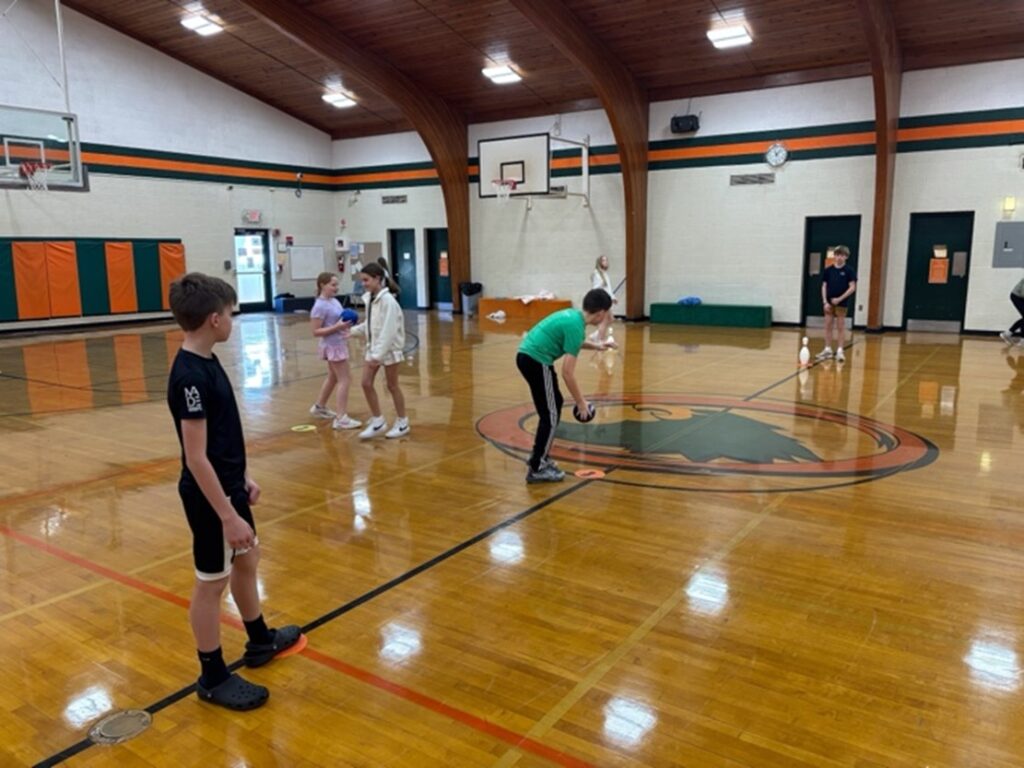One of the things I enjoy most in Physical Education is being able to find and create activities that have the students active the entire time and not realize it. I find that when there is just a lot of running, some students get super tired quickly or lose interest even faster. I created a unit in my curriculum solely to do aerobics games and one of those activities is “Aerobic Bowling” from SPARK. I love this game because students are working together in groups, getting exercise while learning to wait their turns, and learning the fun game of bowling. Now, I have a lot of students leaving the class having had fun, having gotten their full 30 minutes of exercise, and feeling energized!
The Set Up:

The set up for “Aerobic Bowling” is very simple and for my older grades, I tend to make them grab the materials and set it up themselves.When a class does come in, I have one “lane” already set up and I pull 3 students to come and demonstrate for me.
I place them in each spot and talk the class through each spot specifically, then they demonstrate 2 times to show how it is done and how to rotate. If they have any questions after the demonstration we spend 2 minutes answering those. I give my students autonomy in this lesson and allow them to pick their groups for that day’s activity.
Aerobic Bowling:

The students waiting their turn are the ones who perform the exercise, and I try to create a new exercise for them every 2 minutes. This keeps them focused on the change of exercise and ensures they are completing the activity correctly. The last exercise or two, I allow the students to pick their favorite exercise or choose a new one. It is neat to see what each student chooses to do and it allows me to see which exercise they enjoyed the most.
One modification I find that helps with younger students is to complete these “waiting” exercises during the warm-up, so that when I announce the change, they have already practiced them and they know what to do. I also find having print-out cards of the exercise being demonstrated helps all my classes, both younger and older grades; the activity cards are a universal design modification that helps all students transition easily between exercises and prevents disruptions to the game.
Gameplay Variations:
After I have given instructions, I encourage students to study the set-up and then to adjust how close or how far they bowl their ball. I have found that some students are very skilled in the concept of bowling and need an added challenge, so I present the option to back up their starting dot. I have also had to do the opposite and encourage some students to move a little closer to gain confidence and focus on the accuracy of their rolls. I also ensure they are lined up with a straight line on our basketball courts. This really helps my students struggling to roll in a straight line have something to aim for and focus on as they get the hang of things.
Another variation I give my students is the size gator skin ball they can use. I start off with the 7” in diameter so that they can gain consistency in hitting their bowling pin. After observing a few times and seeing them succeed, I offer smaller size gator skin balls to create a challenge for them. Many love having this opportunity because it allows them to improve their roll accuracy.

A third variation I give students is the option to add bowling pins. I start off with one bowling pin that the lesson requires but once they get the hang of the activity, I like to offer up to two or three more pins to each group. It is really neat to see how the students change the layout of the pins for each other. Some students are quite challenging which they love, and other students stick to traditional bowling pin layout.
We all know we have those few students who, no matter the activity, make things competitive. So in addition to the previously-mentioned variations, I created a scoring system for the ultra-competitive groups. This adds an extra layer of challenge because they have to focus on their target, make a good roll, and keep up with adding onto their scores. If more bowling pins get added, then we designate how many points each bowling pin is worth. This allows those students to be fulfilled with a competitive edge to the game, and it also allows my students who are just enjoying the activity to participate without feeling the competitive stress to score points.
Aerobic Bowling SPARK Lesson:
SPARK_36_AerobicGames_L2_WEB-1-2-1Additional SPARK Activities:
As I wrap up “Aerobic Bowling,” I want to also mention a few other units available through SPARK. “Aerobics Golf” is a great activity as well because it similarly focuses on constant movement throughout the class and accuracy on throws. It also allows a scoring system for your competitive students or your golfers. “Builders and Bulldozers” is fantastic and has a few variations to it as well. I can get in about four different rounds with this game based on colors and builders/bulldozers. I have found the 3-Catch Game does better with my older students because they are better with throwing and moving at that age and can handle multiple moving parts to the game.




